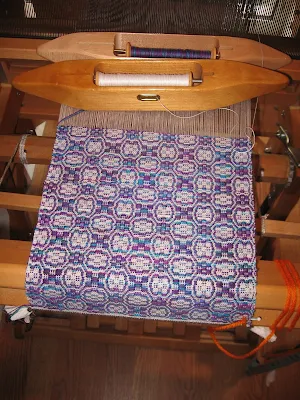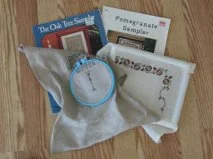That is how the garden grows, and that's how things are progressing here.
The Valley Forge Dogwood scarf progresses steadily and has passed the half-way mark. Had an interesting set back. I was happily weaving away, then realized things just looked off. Not unattractive, just wrong. I wish I'd had the presence of mind to take a picture of what I was getting, but it was late and I was plunged deep into that "What is wrong and what do I do about it?!" panic mode. I finally figured out that my pattern, which is from the Margaret Atwood book, has the treadling pattern written right to left, and my treadles are tied up left to right. I had been "stomping as writ," that is, treadling right to left. And yes, it was very late when this was happening, I should have been in bed hours before. Some artist's tape and a sharpie to remind me of my treadle order has solved the problem. I could re-tie my treadles, but not only would crawling around under that loom be physically painful, but I'm afraid I could mess up my loom for life because of the way the Wolf Pup's harnesses are hooked up to the treadles. The artist's tape solution is much easier.
 |
| Ana one, ana two, ana t'ree.... |
Once this scarf reaches length, if I've some warp left (The odds are good, I give myself lots of room on warps) I may re-treadle the "error" just for my records. The pattern I was getting was not unattractive, it was just not the Dogwood. But that's the fun of overshot. It's not any thing, it's just what it is. Like the Vulcan IDIC - Infinite Diversity, Infinite Combinations. (Gee, Star Trek and hand weaving; I wonder if anybody's ever gotten them in the same sentence before?)
When I took Art History in college, I annoyed the instructor when he announced that "op art" was a completely new was of dealing with color and shape and I asked if he'd ever looked at an overshot coverlet. He was not pleased when I brought him pictures and could show him that women in the hills and hollers of Tennessee and North Carolina were getting "op art" effects on their looms 100 years before Andy Warhol and his crowd came up with it. A quick browse through the 'net let me find this picture of a Double Bow Knot piece, probably woven early in the 20th century, though the pattern is much older. I couldn't find what I was looking for, a picture of a older coverlet where the weaver had used various colors in her warp and weft. The book
Textile Arts from Southern Appalachia: the Quiet Work of Women has some marvelous examples of coverlets woven in the late 1800s and early 1900s that show a skill with pattern and color that would make a modern artist weep with envy if they would look at them. (A personal rant I will spare you because as someone who does "craft and "fine art" and "illustration" I know I can far too easily start frothing at the mouth on the subject. Suffice it to say that it really annoys me that somebody can go on line, print out a bunch of black and white images, cut them into strips, paste the strips onto squares of foam core, piece the squares into a kimono shape with wire loops, hang them on a wire, enter them into a Fine Arts show and win a prize, while I can hand-spin silk, dye it, hand-weave the fabric, sew a kimono and not be able to even bring it into the same room as the foam core and glued-up printer paper because it is "craft." Grrrrrrrrr.....)
 |
| From HistoricWeaving.com, a piece that shows what my art professor assured me were uniquely 20th Century approaches to the use of color and form for "vibrational optical effect." Yeah, right buddy. |
I decided to re-visit Wendy Johnson's
Seriously Simple Shawl that I started at a knitting class at my LYS in an attempt to learn to knit lace and read charts. Step One: figure out where you left off. First the stitch count was off. So I did a stitch-by-stitch reading and realized nothing on the chart corresponded with what I had on my needles. I finally figured out that while in class I had missed the center stitches, and had been doing so for several inches. Nothing to do but start over again. Which meant going to You Tube to figure out how to do a tab start. So I started again. And promptly got into trouble again. And again. Sometimes the only thing keeps me sane is my conviction that you learn more about an art or craft when things go badly than than when things go well because it makes you really dig into how it all actually works. But then, there's also wisdom in the quote "If at first you don't succeed, try, try again. If you can't do it then, you may as well give up, there's no point being a damned fool about it." So that is now a ball of yarn and set aside for the time being
 |
| "Seriously Simple" is in for a serious wait. |
So I went back to another start, the
Lacy Prairie Shawl from Cheryl Oberle's
Folk Shawl book. Her
Simple Garter Stitch Prairie Shawl was the first major project I ever did - though I suspect it's about half the size it's supposed to be. When it got big enough I could almost sit on it - and I am not a short woman - I decided it was time to call it a day. (I really like the patterns in this book, but now that I've been working
them, they seem awfully big to me, some of them nearly blanket-size.
Has anybody else noticed this?) I still had about half the yarn I'd bought for the project left, Cascade Heathers, a beautiful flecked green that reminds me of the rhododendron and mountain laurel on the Blue Ridge, so I decided to tackle the other prairie shawl. When I took a closer look at what I'd done, I decided I was not happy with the lace, it looked lumpy to me. So true to form I've taken it apart and am started it on larger needles. I think my guess was right; I am happier with how it's coming together. That at the moment, I can only knit even the simplest lace by myself in complete silence with no distractions. It takes my complete concentration, even a cat going by is enough to mess me up!
 |
| Teah, the Queen-cat, plotting her next distraction |
Ever onward....

















































